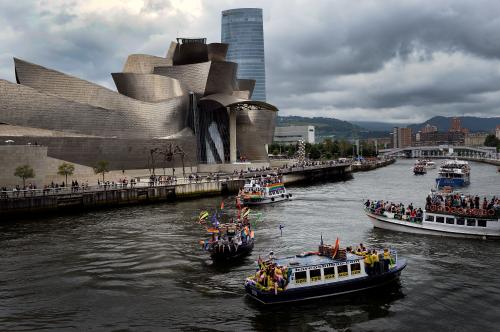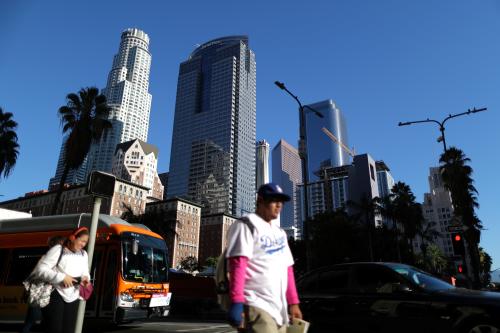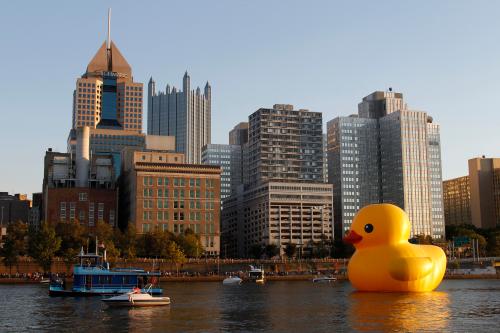As 47 countries get ready to report their progress next week on the Sustainable Development Goals (SDGs) at the United Nations’ annual check-in (the High-level Political Forum, or HLPF), a quiet revolution is brewing below the surface. Cities worldwide are preparing their own reviews despite not being parties to the agreement nor an official part of the formal review activities—translating the national and global aspirations of the SDGs into progress at the local level.
Last summer New York City pioneered the first-ever Voluntary Local Review (VLR) to the U.N. to report its local contributions to the SDGs, presenting a city-specific review based on the Voluntary National Reviews (VNRs) that countries formally submit to the U.N.
By then multiple cities globally had begun serious adaptation of the SDGs. They were undertaking activities such as mapping their city strategies to the goals; identifying key data and metrics to measure progress; creating priority initiatives and programs; consulting with citizens and other partners; and publishing dashboards. New York’s VLR provided a commonly understood and universally accessible tool that cities could use to capture and communicate their commitments and progress.
Cities as diverse as Helsinki, Los Angeles, Bristol, Buenos Aires, Orlando, Kitakyushu, and Santana de Parnaiba are undertaking or have completed a VLR. Many more are lining up.
Cities are being innovative in their processes and uses for a VLR, targeting different audiences and initiating the reviews at different junctures of their SDG localization. Since there is no universally accepted set of locally adapted targets based on the SDGs, nor official indicators or metrics, there is a great deal of flexibility in undertaking such an assessment. At the same time, the open-endedness can make it hard to get started and could potentially threaten the tool’s credibility if VLRs become no more than rhetorical devices.
Within this context, a team of students from Carnegie Mellon University’s Heinz College of Information Systems and Public Policy—Niki Deininger, Jason Griess, Yasu Lu, and Robert Santamaria—developed this prototype handbook for city officials interested in doing a VLR. Completed as part of a semester-long capstone project, the handbook provides guidance without prescribing a one-size-fits-all approach, attempting to balance flexibility with ensuring a viable minimum product that retains credibility and rigor—and provides value to the city and its citizens.
Several key lessons emerge:
- Through a VLR, cities can leverage the integrated nature and common language of the SDGs to break down silos among offices and agencies that might benefit from taking on issues together. For example, a VLR provides an incentive to explore the relationship among priorities related to climate change and environmental protection with those focused on equity, jobs, and governance. The impetus to undertake a VLR benefits from mayoral commitment, but might also be just as useful as a bottom-up effort initiated by city staff or with the support of an outside entity, such as a university.
- The need to collect, arrange, and publish data that measures local outcomes may be challenging but provides the basis for evidence-based policymaking and attracting support and resources from local partners. A VLR provides the opportunity to extract data from relevant agencies and combine it with publicly available data to shape a narrative and story that is accessible and understood by citizens, and provides a foundation for engaging businesses, civil society, and philanthropy.
- Honesty and transparency about challenges or gaps are integral to generating the momentum to make progress on tough social and environmental issues. While the VNRs that countries report to the U.N. have been criticized for being overly positive and promotional, cities have an opportunity to change that. Cities are becoming renowned for sharing innovations and combining efforts on their toughest challenges with their peers across borders; rigorous and frank VLRs can be the basis for maximizing such learning and collective momentum. Getting cities to agree to all report on a standard data floor, a basic subset of indicators for each goal, could help.
This handbook arrives as a contribution to a new and emerging field as others are working on similar products. For example, the Institute for Global Environmental Strategies (IGES) is working to standardize a VLR approach in Japan and Malaysia, and has launched an online VLR Lab; the Joint Research Centre of the European Commission is drafting a VLR handbook for the EU, to be launched in early 2020; the University of Bristol, which completed Bristol’s VLR with cooperation from the city, is planning to publish a U.K. VLR handbook; and Red de Ciudades Cómo Vamos is building upon their work to localize SDG indicators to support VLRs for cities in Colombia.
The U.N. is now posting reports that local governments have created, and encouraging this diverse ecosystem of providers to grow will be more constructive than attempting to centralize and standardize. Regional and even national differences in the format and content of a VLR should be welcomed, especially if the objective is to achieve scale. This handbook captures the experience and lessons of selected early adopters, providing a meaningful building block for others to carry forward, expanding and leveraging the leadership of mayors and local leaders to advance the SDGs.
The Brookings Institution is committed to quality, independence, and impact.
We are supported by a diverse array of funders. In line with our values and policies, each Brookings publication represents the sole views of its author(s).







Commentary
A handbook to help cities report local progress on the Sustainable Development Goals
July 9, 2019